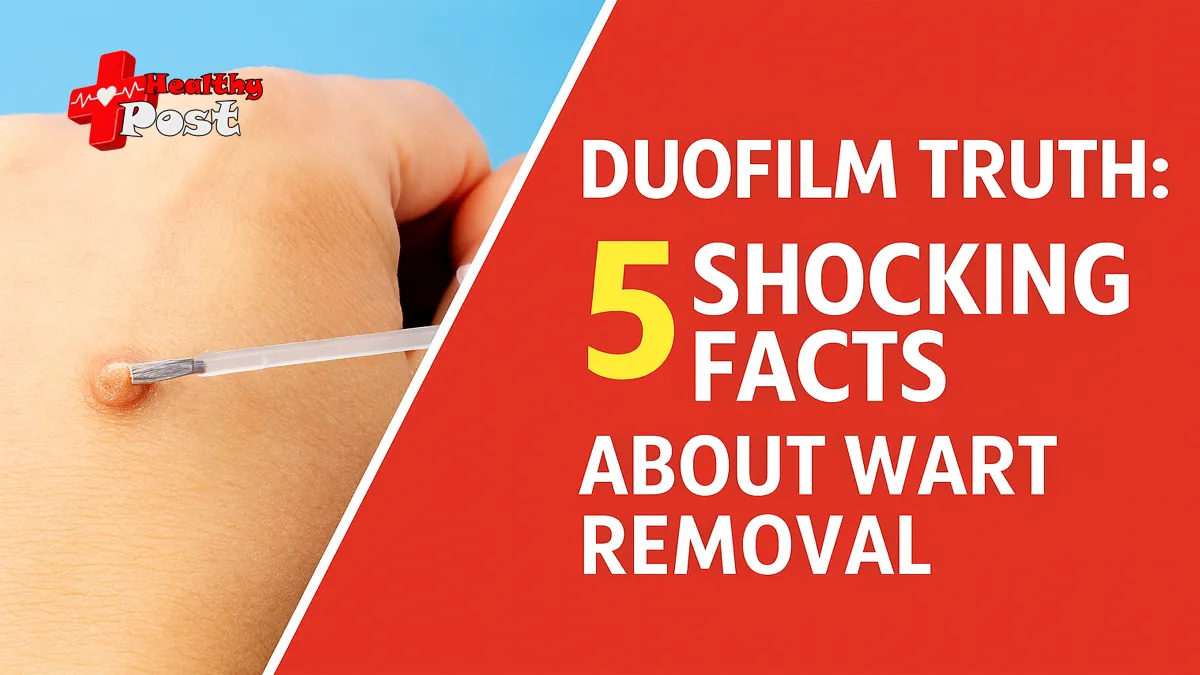
Duofilm Truth: 5 Shocking Facts About Wart Removal
If you’ve been dealing with stubborn warts and wondering if there’s a simple, affordable solution, you’ve probably heard of Duofilm. Duofilm is a popular over-the-counter wart remover that many people swear by—and others say didn’t work for them. So what’s the truth? In this guide, we’ll unpack what makes Duofilm effective, who it works best for, how to avoid common mistakes, and five surprising facts that can make or break your results. Whether you’re new to wart treatments or you’ve tried a few already, this is your friendly, no-nonsense roadmap.
We’ll cover how Duofilm works, what to expect, how to use it safely, and how it compares to other options—so you can make a smart, confident decision for your skin.
Keywords you might be searching for include duofilm wart, duofilm wart remover, and of course, Duofilm itself. If that’s you, you’re in the right place.
What Is Duofilm—and Why Do People Use It?
Duofilm is an over-the-counter liquid wart remover designed to gradually dissolve common warts and plantar warts. Its main active ingredient is salicylic acid, a keratolytic, which means it helps shed layers of thickened skin. Over time, this peeling action disrupts the wart tissue and allows healthy skin to replace it.
- Type: Topical liquid solution
- Common targets: Common warts (hands, fingers) and plantar warts (soles of the feet)
- How it’s used: Applied daily to the wart, then allowed to dry. The softened skin is often gently filed between applications.
Think of Duofilm like a consistent, gentle “eraser” for wart tissue—less dramatic than freezing, but much more controllable at home.
The 5 Shocking Facts About Wart Removal With Duofilm
1) It’s Not About Strength—It’s About Consistency
Here’s the surprise: Duofilm isn’t a “one-and-done” product. Unlike in-office treatments like cryotherapy, Duofilm works gradually. This is both its superpower and its biggest “gotcha.”
- What shocks most people: Results often take weeks, not days.
- Why consistency wins: Salicylic acid loosens the layers of wart tissue, which regenerates slowly. Daily applications slowly tip the balance in your favor.
- The realistic timeline:
- Small common warts: 2–6 weeks
- Plantar warts (thicker): 4–12 weeks
- The “invisible progress” test: If the wart is getting smaller, less painful, or shows black dots (dead capillaries), you’re likely on track—even if it doesn’t look “gone” yet.
Real-life example:
- Priya used Duofilm once every few days and gave up after two weeks—no change. She restarted with daily application, covering only the wart and gently filing every 3–4 days. By week five, the central core had lifted out, and the skin flattened. Consistency was the missing ingredient.
Takeaway: If you choose Duofilm, your routine—not brute strength—is what makes it work.
2) Targeting Only the Wart Is Half the Battle
Duofilm wart treatment works best when it stays on the wart and off healthy skin. That sounds obvious, but this is where many people go wrong.
- Why precision matters:
- Spreading onto healthy skin can cause irritation, redness, or peeling.
- Focusing on the wart concentrates the active ingredient where it counts.
- Easy precision hacks:
- Use a cotton swab or the smallest brush tip you can manage.
- Apply petroleum jelly around the wart as a “barrier ring.”
- Let Duofilm dry completely before putting on socks or gloves.
- When dealing with plantar warts:
- After drying, a small piece of non-woven tape or a bandage can help keep the liquid in place.
- A pumice stone or emery board (used gently, on dry skin) every 2–3 days helps remove loosened layers.
Real-life example:
- Mike stopped experiencing irritation once he started masking the healthy skin with a thin ring of petroleum jelly. His “precision upgrade” made it easier to stay compliant every day.
Takeaway: A small targeting tweak can dramatically improve comfort and results.
3) Wart Biology Means You Might See “Black Dots”—That’s Often Good
This is one of the most misunderstood parts of wart removal. The little black dots you may see in a wart aren’t “dirt.” They’re tiny clotted blood vessels that feed the wart. Seeing more of them as layers peel isn’t a bad sign.
- What black dots mean:
- They can indicate the wart is being disrupted and “starved.”
- As the wart reduces, these dots may become more visible before the tissue sloughs off.
- What to do:
- Do not forcibly cut or pick them out.
- Keep up the routine: apply Duofilm, let it dry, and gently file every few days.
- When to pause:
- If you see bleeding, significant pain, or spreading redness, stop and reassess. Irritation is a cue—not a goal.
Takeaway: Black dots are often a sign you’re getting to the root of the problem.
4) Plantar Warts Need Pressure Strategy—Not Just Acid
Plantar warts are notorious for being stubborn because they live under pressure points on the foot. Duofilm helps chemically, but mechanics matter too.
- Pressure and friction can drive the wart deeper and thicker.
- Simple plantar success formula:
- Keep up daily Duofilm.
- Use a donut-style pad or cushioned insole to offload pressure.
- Wear breathable, well-fitting shoes and moisture-wicking socks.
- Gently file every few days to remove dead layers and let the active ingredient penetrate.
Real-life example:
- A runner with a painful heel wart saw slow progress with Duofilm alone. After adding a gel heel cushion and reducing high-impact runs for a few weeks, the wart finally flattened and disappeared by week eight.
Takeaway: For plantar warts, lighten the load—literally—and Duofilm works better.
5) The Biggest “Fail” Is Stopping Too Early
One of the most shocking truths about wart removal isn’t about chemistry—it’s about patience. Stopping once it “looks better” is where many relapses happen.
- Why relapses occur:
- The virus-infected wart tissue can linger below the surface even after the top looks smooth.
- How to prevent the comeback:
- Continue Duofilm for 1–2 weeks after the wart appears gone, as long as the skin tolerates it.
- Keep an eye on the area for a month; resume early if roughness returns.
- Signs you’re truly done:
- Normal skin lines return across the area.
- No tenderness on pressure.
- No visible roughness or “peppery” dots.
Takeaway: Go a little longer than you think—this “overlap” is your relapse insurance.
How to Use Duofilm Safely and Effectively (Step-by-Step)
Here’s a simple routine you can follow. Always read and follow the product label instructions for your specific Duofilm wart remover.
- Prep the skin
- Soak the area in warm water for 5–10 minutes or take a shower.
- Pat dry completely.
- Thin the surface (every 2–3 days)
- Gently file the top of the wart with an emery board or pumice to remove dead layers.
- Avoid filing until bleeding; just smooth the roughness.
- Protect surrounding skin
- Apply a thin smear of petroleum jelly around the wart to shield healthy skin.
- Apply Duofilm
- Use a cotton swab or applicator to place a tiny drop directly on the wart.
- Let it dry fully before covering the area or putting on socks/gloves.
- Cover if needed
- For plantar warts, a breathable bandage can help keep the medication in place and reduce friction.
- Repeat daily
- Consistency is key; set a reminder on your phone.
- Continue 1–2 weeks past “gone”
- Helps prevent recurrence.
Safety notes:
- Avoid use on the face, genitals, mucous membranes, or large areas.
- Do not use on irritated, infected, or inflamed skin.
- Keep away from children; avoid contact with eyes.
- If you have diabetes, poor circulation, neuropathy, or are pregnant, consult a healthcare professional before using any wart remover.
Common Mistakes to Avoid
- Using too much product at once (more isn’t better; aim for precision).
- Skipping days (breaks reset progress).
- Not drying the area fully before application.
- Picking or cutting the wart (increases infection risk and can spread the virus).
- Ignoring foot mechanics for plantar warts (add cushioning/offloading).
- Quitting as soon as it looks better (continue past “clear” for 1–2 weeks).
Duofilm vs. Other Wart Removal Options
Here’s a quick comparison to help you decide if a duofilm wart approach is right for you versus other methods.
| Treatment | How It Works | Typical Timeline | Pain Level | Best For | At-Home vs In-Office | Cost Range |
|---|---|---|---|---|---|---|
| Duofilm (salicylic acid) | Peels wart layer-by-layer | 2–12 weeks | Low to moderate (can sting/peel) | Common and plantar warts | At-home | Low |
| Cryotherapy (freezing) | Freezes wart to destroy tissue | Every 2–3 weeks, 1–4 sessions | Moderate to high during/after | Stubborn or larger warts | In-office; some at-home kits | Medium to high |
| Cantharidin (blistering agent) | Causes blister to lift wart | 1–3 sessions | Moderate | Kids or those avoiding needles | In-office | Medium |
| Laser therapy | Burns/destroys wart tissue | 1–3 sessions | Moderate to high | Resistant warts | In-office | High |
| Duct tape occlusion | Starves wart of oxygen | Weeks to months | Low | Mild cases, adjunct therapy | At-home | Very low |
| Immunotherapy | Stimulates immune response | Weeks to months | Variable | Recalcitrant warts | In-office | High |
Key insight: Duofilm is a strong first-line option for many people because it’s affordable, non-invasive, and effective with consistent use. For very stubborn or painful warts, professional treatments may be faster.
Who Should Consider Duofilm First?
- You prefer a low-cost, gradual at-home option.
- You have common warts or plantar warts that aren’t severe.
- You can commit to a daily routine for several weeks.
- You’re okay with mild peeling and some tenderness.
Who should see a healthcare professional before using a duofilm wart remover:
- You have diabetes, neuropathy, or circulation issues.
- The wart is on your face, genitals, or a very sensitive area.
- The lesion bleeds easily, changes quickly, or you’re unsure it’s a wart.
- You’ve tried for 2–3 months with no progress.
Real-Life Success Blueprint: A Simple Weekly Rhythm
- Daily:
- Apply Duofilm after washing and drying.
- Let dry fully; cover only if needed.
- Every 2–3 days:
- Gently file to remove softened layers.
- Weekly check-in:
- Track changes in size, tenderness, and appearance.
- Adjust footwear or add pads for plantar warts.
- After clearance:
- Continue for 1–2 extra weeks to reduce recurrence.
Pro tip: Take quick phone photos weekly. Progress can be subtle day-to-day but obvious week-to-week.
Frequently Asked Questions
Q: How long before I see results with Duofilm?
- Many people notice softening and flattening within 2–4 weeks, with full clearance often in 4–12 weeks depending on wart size and location.
Q1: Does Duofilm hurt?
- Some mild stinging or tenderness is common as layers peel. If you experience significant pain, stop and reassess your application technique or take a day off.
Q2: Can Duofilm spread the virus?
- The product itself doesn’t spread the virus, but picking or shaving the area can. Keep tools clean and avoid sharing emery boards or pumice stones.
Q3: Can I use duofilm wart remover on children?
- Always check age guidance on the label and consult a healthcare professional for young children. Avoid facial/genital use.
Q4: The wart looks better but not gone—should I keep going?
- Yes. Continue 1–2 weeks past “clear” if the skin tolerates it to help prevent recurrence.
Visual Aid: Quick Routine Checklist
| Step | Action | Why It Helps |
|---|---|---|
| 1 | Soak and dry | Softens outer layers for better penetration |
| 2 | Gently file (q2–3 days) | Removes dead skin so Duofilm reaches active tissue |
| 3 | Protect healthy skin | Reduces irritation and keeps you consistent |
| 4 | Apply Duofilm precisely | Targets wart, not healthy skin |
| 5 | Let dry fully | Prevents transfer and irritation |
| 6 | Offload pressure (plantar) | Helps the wart shrink instead of burrow |
| 7 | Continue past “clear” | Lowers risk of recurrence |
When to See a Professional
While Duofilm is a solid first-line approach, seek medical advice if:
- You’re not seeing meaningful progress after 8–12 weeks of consistent use.
- The area becomes very painful, red, or shows signs of infection.
- You’re uncertain it’s a wart (especially for facial or changing lesions).
- You have a condition like diabetes or poor circulation.
A clinician can offer cryotherapy, cantharidin, laser treatment, or immunotherapy—especially helpful for persistent plantar warts.
The Bottom Line: Is Duofilm Worth It?
Yes—if you’re patient and precise. Duofilm is an accessible, budget-friendly, and evidence-based way to remove common and plantar warts at home. The “shocking” truth isn’t that it magically erases warts overnight—it’s that consistent, targeted use over a few weeks can quietly beat even stubborn warts. For many, a duofilm wart remover routine is the perfect blend of control, comfort, and cost-effectiveness.
Stick with the plan, protect your healthy skin, and give it time. And remember: if you hit a wall, help from a professional can speed things along.
Stay patient. Stay kind to your skin. You’ve got this.
Quick Recap of the 5 Shocking Facts About Duofilm Wart Removal
- Consistency, not strength, drives success.
- Precision around the wart protects healthy skin and boosts results.
- Black dots often mean you’re reaching the wart’s core—don’t panic.
- Plantar warts need pressure relief alongside acid.
- Stopping too early invites a comeback—continue 1–2 weeks past “clear.”
Conclusion
Duofilm is a powerful ally when you want an at-home, budget-friendly way to tackle warts. Use it consistently, aim precisely, add smart foot care for plantar warts, and keep going a little past “clear.” If you treat it like a routine rather than a quick fix, Duofilm can be exactly what you need to finally move on from stubborn warts—confidently and safely.


2 thoughts on “Duofilm Truth: 5 Shocking Facts About Wart Removal”